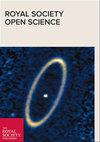5-(吡啶-3-基)-3,4-二氢-2H-呋喃-1-鎓(NNKFI):对其物理化学性质的计算研究。
IF 2.9
3区 综合性期刊
Q1 MULTIDISCIPLINARY SCIENCES
引用次数: 0
摘要
最近关于 4-(甲基亚硝基氨基)-1-(3-吡啶基)-1-丁酮(NNKDI)重氮离子代谢物的研究表明,5-(吡啶-3-基)-3,4-二氢-2H-呋喃-1-鎓(NNKFI)可能是由 NNKDI 通过分子内反应形成的。NNKDI 是一种重要的致癌物质,其作为烷化剂的作用受到了广泛关注。虽然有一些实验证据支持 NNKFI 在体外生成,但尚未对其进行直接观察。人们对 NNKFI 的结构和反应性知之甚少。我们报告了对这种离子的首次硅学研究。我们的研究利用 Kohn-Sham 密度泛函理论(B3LYP/6-311G**)和耦合簇理论(CCSD/6-31G*)来生成 NNKFI 的能量优化结构、振动常态模式和分子轨道。为了深入了解该物种的化学特性,我们计算了静电位面、天然种群分析电荷和局部 Fukui 指数。我们报告了 NNKFI 顺式和反式构象的数据和结果。我们的研究证实 C5 是 NNKFI 亲核攻击的首选位点。O1 附近的伸展运动和预测键长与该离子中略微减弱的羰基结构一致。局部电荷、静电位面和局部 Fukui 指数揭示了呋喃分子上阳离子电荷的分散以及 C5 处显著的碳位特征。本文章由计算机程序翻译,如有差异,请以英文原文为准。
5-(Pyridin-3-yl)-3,4-dihydro-2H-furan-1-ium (NNKFI): a computational study of its physico-chemical properties.
Recent work on the diazonium ion metabolite of 4-(methylnitrosamino)-1-(3-pyridyl)-1-butanone (NNKDI) suggests that 5-(pyridin-3-yl)-3,4-dihydro-2H-furan-1-ium (NNKFI) may form from NNKDI via an intramolecular reaction. NNKDI is an important carcinogen whose role as an alkylating agent has received significant attention. While there is some experimental evidence supporting NNKFI's production in vitro, it has not yet been directly observed. Little is known about NNKFI's structure and reactivity. We report the first in silico examination of this ion. Our study utilized Kohn-Sham density functional theory (B3LYP/6-311G**) and coupled cluster theory (CCSD/6-31G*) to produce energy-optimized structures, vibrational normal modes and molecular orbitals for NNKFI. To gain insight into the chemical properties of this species, we calculated electrostatic potential surfaces, natural population analysis charges and local Fukui indices. We report data and results for NNKFI's cis and trans conformers. Our work confirms C5 as the preferred site for nucleophilic attack in NNKFI. Stretching motions and predicted bond lengths near O1 are consistent with a somewhat weakened carbonyl structure in this ion. Partial charges, electrostatic potential surfaces and local Fukui indices reveal delocalization of cationic charge on the furanium moiety and notable carbocation character at C5.
求助全文
通过发布文献求助,成功后即可免费获取论文全文。
去求助
来源期刊

Royal Society Open Science
Multidisciplinary-Multidisciplinary
CiteScore
6.00
自引率
0.00%
发文量
508
审稿时长
14 weeks
期刊介绍:
Royal Society Open Science is a new open journal publishing high-quality original research across the entire range of science on the basis of objective peer-review.
The journal covers the entire range of science and mathematics and will allow the Society to publish all the high-quality work it receives without the usual restrictions on scope, length or impact.
 求助内容:
求助内容: 应助结果提醒方式:
应助结果提醒方式:


